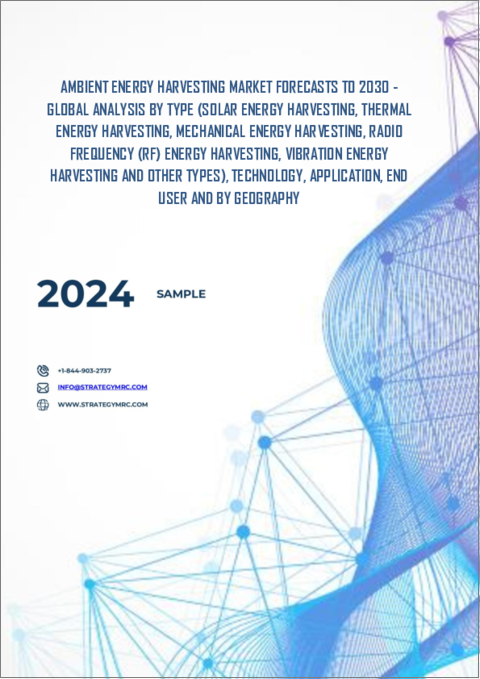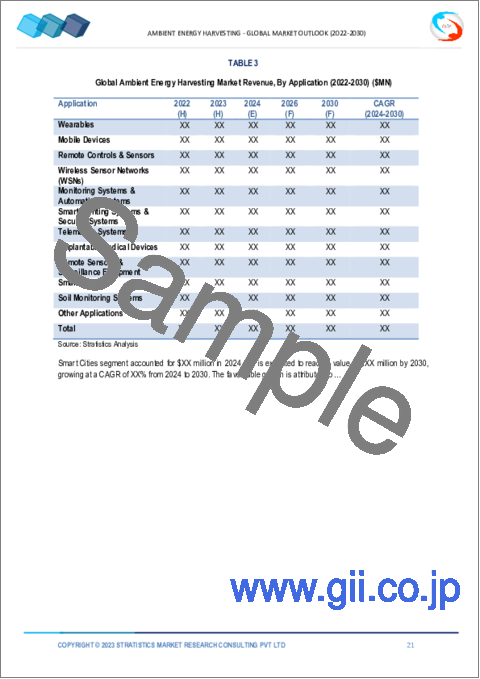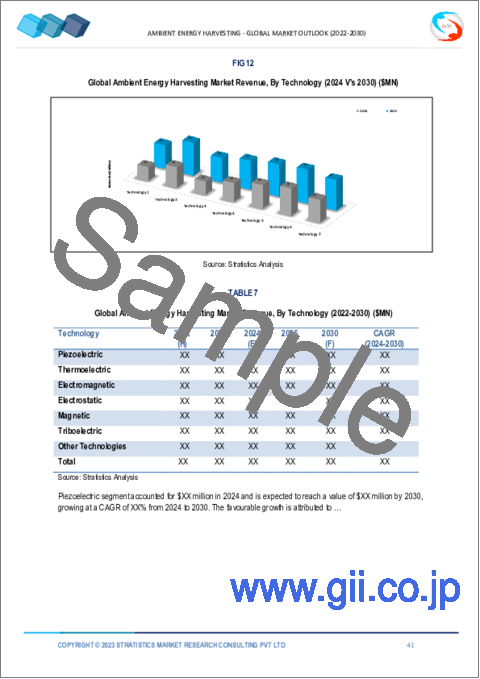|
|
市場調査レポート
商品コード
1558340
環境エネルギーハーベスティング市場の2030年までの予測: タイプ別、技術別、用途別、エンドユーザー別、地域別の世界分析Ambient Energy Harvesting Market Forecasts to 2030 - Global Analysis By Type, Technology, Application, End User and By Geography |
||||||
カスタマイズ可能
|
|||||||
| 環境エネルギーハーベスティング市場の2030年までの予測: タイプ別、技術別、用途別、エンドユーザー別、地域別の世界分析 |
|
出版日: 2024年09月06日
発行: Stratistics Market Research Consulting
ページ情報: 英文 200+ Pages
納期: 2~3営業日
|
全表示
- 概要
- 図表
- 目次
Stratistics MRCによると、世界の環境エネルギーハーベスティング市場は予測期間中にCAGR 12.1%で成長しています。
環境エネルギーハーベスティングは、環境からエネルギーを取り込み、使用可能な電気エネルギーに変換するプロセスです。太陽エネルギー、熱エネルギー、振動エネルギー、運動エネルギー、電磁エネルギーなど、さまざまなエネルギー源を利用して、小型電子機器、特にセンサーやウェアラブルのようなワイヤレスで自律的な機器に電力を供給します。用途としては、環境モニタリング用のワイヤレス・センサー・ネットワーク、健康指標を追跡するウェアラブル電子機器、遠隔地での自律型機器などがあります。この技術の利点には、持続可能性、寿命の長さ、費用対効果などがあります。エネルギーハーベスティング技術における最近の動向は、圧電発電機や熱電デバイスなど、周囲のエネルギーを効率的に電気に変換できるコンパクトで効果的なシステムの開発につながっています。
IoTデバイス、ウェアラブル、センサーの普及
IoTデバイスやウェアラブルからの電力需要の増加により、環境エネルギーハーベスティングシステムの開発が必要となっています。これらのシステムは、頻繁なバッテリー交換や外部電源なしに、信頼性の高い継続的な電力供給を提供することができます。小型でポータブルなデバイスへの動向は、コンパクトで効率的な電力ソリューションのために、これらのシステムの統合を必要とします。さらに、これらのシステムは、リモート・アプリケーション用のIoTデバイスに統合することができ、貴重なデータと洞察を提供します。
低エネルギー出力
環境エネルギーハーベスターの出力は、高出力デバイスには不十分なことが多く、ワイヤレス・センサーやウェアラブルのような低出力デバイスへの応用が制限されます。また、太陽光や風力のようないくつかのエネルギー源の断続的な性質は、継続的なデバイス動作のために周囲エネルギーハーベスティングのみに依存することを困難にしており、市場成長の妨げとなる電力供給のギャップを埋めるためのエネルギー貯蔵ソリューションが必要となります。
持続可能なエネルギー・ソリューションに対する意識の高まり
持続可能なエネルギーソリューションの推進は、国連の持続可能な開発目標(SDGs)などの世界のイニシアティブと密接に結びついています。環境エネルギーハーベスティング技術は、従来の電力網から独立して動作できる、低負荷でエネルギー効率の高いシステムの開発を可能にすることで、これらの目標に貢献しています。この能力は、特に遠隔地や十分なサービスを受けていない地域において、エネルギーの持続可能性と安全性を達成するために極めて重要です。
空間的・時間的制約
太陽エネルギーや風力エネルギーシステムのような環境エネルギーハーベスティング技術は、特定の地理的条件に大きく依存します。同様に、風力エネルギー・ハーベスティングは、風速が低い地域では実行可能性が低いです。この地理的依存性は、必要な環境エネルギー資源が容易に入手できない地域でのエネルギー・ハーベスティング・システムの普及を妨げ、市場の成長を制限する可能性があります。
COVID-19の影響:
COVID-19の大流行は、環境エネルギーハーベスティング市場にさまざまな影響を与えました。当初はサプライチェーンが混乱し、製造やプロジェクト実施の遅れにつながった。しかし、パンデミックは遠隔監視やIoTデバイスの採用を加速させ、持続可能な電力ソリューションへの需要を増加させました。組織は現在、エネルギー効率と環境フットプリントの削減により重点を置いており、これが環境エネルギーハーベスティング技術にチャンスをもたらしています。
太陽エネルギーハーベスティング分野は予測期間中最大となる見込み
太陽エネルギーハーベスティングは、信頼できる電源を提供することで効率と自律性を向上させ、ワイヤレスセンサーやIoTアプリケーションのようなデバイスが自律的に動作することを可能にする技術であるため、予測期間中に最大になると予想されます。これは、スマート農業、環境モニタリング、都市インフラを含む太陽エネルギーハーベスティング技術のアプリケーションの範囲を拡大し、エネルギーハーベスティングソリューションの市場需要の増加と技術革新につながっています。
予測期間中にCAGRが最も高くなると予想されるのは電磁気セグメントです。
RFエネルギーを使用可能な直流電力に変換する効率的なレクテナシステムの統合により、コスト効率が向上しているため、電磁気セグメントは予測期間中に最も高いCAGRを有すると予想されます。これにより、企業の運用コストが下がり、広範な使用にとってより魅力的なものとなります。これらの技術は、スマートシティ、ヘルスケア、産業用モニタリングなどの分野で使用され、継続的な電力供給を実現しています。
最大のシェアを占める地域
北米は、人口拡大と産業オートメーションの成長に伴うウェアラブル・エレクトロニクス需要の高まりにより、予測期間中最大の市場シェアを占めると予測されています。加えて、この地域では再生可能エネルギーへの巨額の投資が行われており、同地域の市場成長にプラスの影響を与えると思われます。さらに、この地域は、化石燃料への依存を減らし、気候変動を緩和するための再生可能エネルギー構想への投資が増加しているため、今後数年間はプラスに成長すると思われます。
CAGRが最も高い地域:
アジア太平洋地域は、予測期間中に最も高いCAGRを示すと予測されます。アジア太平洋地域の政府は、持続可能な電力ソリューションを必要とするスマートシティプロジェクトに投資しています。環境エネルギーハーベスティング技術は、環境モニタリングや交通管理に不可欠です。民生用電子機器や産業用オートメーションにおけるエネルギーハーベスティング・ソリューションの需要の高まりが、市場の成長を促進しています。
無料カスタマイズサービス:
本レポートをご購読のお客様は、以下の無料カスタマイズオプションのいずれかを受けることができます:
- 企業プロファイル
- 追加市場プレイヤーの包括的プロファイリング(3社まで)
- 主要企業のSWOT分析(3社まで)
- 地域セグメンテーション
- 顧客の関心に応じた主要国の市場推計・予測・CAGR(注:フィージビリティチェックによる)
- 競合ベンチマーキング
- 製品ポートフォリオ、地理的プレゼンス、戦略的提携に基づく主要企業のベンチマーキング
目次
第1章 エグゼクティブサマリー
第2章 序文
- 概要
- ステークホルダー
- 調査範囲
- 調査手法
- データマイニング
- データ分析
- データ検証
- 調査アプローチ
- 調査情報源
- 1次調査情報源
- 2次調査情報源
- 前提条件
第3章 市場動向分析
- 促進要因
- 抑制要因
- 機会
- 脅威
- 技術分析
- 用途分析
- エンドユーザー分析
- 新興市場
- COVID-19の影響
第4章 ポーターのファイブフォース分析
- 供給企業の交渉力
- 買い手の交渉力
- 代替品の脅威
- 新規参入業者の脅威
- 競争企業間の敵対関係
第5章 世界の環境エネルギーハーベスティング市場:タイプ別
- 太陽エネルギーの採取
- 熱エネルギーの採取
- 機械的エネルギー収集
- 無線周波数(RF)エネルギーハーベスティング
- 振動エネルギーの収集
- その他のタイプ
第6章 世界の環境エネルギーハーベスティング市場:技術別
- 圧電
- 熱電
- 電磁
- 静電気
- 磁気
- 摩擦電気
- その他の技術
第7章 世界の環境エネルギーハーベスティング市場:用途別
- ウェアラブル
- モバイルデバイス
- リモコンとセンサー
- ワイヤレスセンサーネットワーク(WSN)
- 監視システムと自動化システム
- スマート照明システムとセキュリティシステム
- テレマティクスシステム
- 埋め込み型医療機器
- リモートセンサーと監視機器
- スマートシティ
- 土壌モニタリングシステム
- その他の用途
第8章 世界の環境エネルギーハーベスティング市場:エンドユーザー別
- 住宅
- 商業
- 産業
- ヘルスケア
- 農業
- 輸送・自動車
- 軍事・防衛
- その他のエンドユーザー
第9章 世界の環境エネルギーハーベスティング市場:地域別
- 北米
- 米国
- カナダ
- メキシコ
- 欧州
- ドイツ
- 英国
- イタリア
- フランス
- スペイン
- その他欧州
- アジア太平洋
- 日本
- 中国
- インド
- オーストラリア
- ニュージーランド
- 韓国
- その他アジア太平洋地域
- 南米
- アルゼンチン
- ブラジル
- チリ
- その他南米
- 中東・アフリカ
- サウジアラビア
- アラブ首長国連邦
- カタール
- 南アフリカ
- その他中東とアフリカ
第10章 主な発展
- 契約、パートナーシップ、コラボレーション、合弁事業
- 買収と合併
- 新製品発売
- 事業拡大
- その他の主要戦略
第11章 企業プロファイリング
- Arveni
- Convergence Wireless
- Cymbet Corporation
- Cypress Semiconductor Corp
- EnOcean Gmb
- Fujitsu
- Honeywell International Inc
- Infinite Power Solution Inc.
- Linear Technologies
- Murata Manufacturing Co. Ltd.
- Powercast Corporation
- Siemens AG.
- STMicroelectronics, Inc
- Texas Instruments Limited
List of Tables
- Table 1 Global Ambient Energy Harvesting Market Outlook, By Region (2022-2030) ($MN)
- Table 2 Global Ambient Energy Harvesting Market Outlook, By Type (2022-2030) ($MN)
- Table 3 Global Ambient Energy Harvesting Market Outlook, By Solar Energy Harvesting (2022-2030) ($MN)
- Table 4 Global Ambient Energy Harvesting Market Outlook, By Thermal Energy Harvesting (2022-2030) ($MN)
- Table 5 Global Ambient Energy Harvesting Market Outlook, By Mechanical Energy Harvesting (2022-2030) ($MN)
- Table 6 Global Ambient Energy Harvesting Market Outlook, By Radio Frequency (RF) Energy Harvesting (2022-2030) ($MN)
- Table 7 Global Ambient Energy Harvesting Market Outlook, By Vibration Energy Harvesting (2022-2030) ($MN)
- Table 8 Global Ambient Energy Harvesting Market Outlook, By Other Types (2022-2030) ($MN)
- Table 9 Global Ambient Energy Harvesting Market Outlook, By Technology (2022-2030) ($MN)
- Table 10 Global Ambient Energy Harvesting Market Outlook, By Piezoelectric (2022-2030) ($MN)
- Table 11 Global Ambient Energy Harvesting Market Outlook, By Thermoelectric (2022-2030) ($MN)
- Table 12 Global Ambient Energy Harvesting Market Outlook, By Electromagnetic (2022-2030) ($MN)
- Table 13 Global Ambient Energy Harvesting Market Outlook, By Electrostatic (2022-2030) ($MN)
- Table 14 Global Ambient Energy Harvesting Market Outlook, By Magnetic (2022-2030) ($MN)
- Table 15 Global Ambient Energy Harvesting Market Outlook, By Triboelectric (2022-2030) ($MN)
- Table 16 Global Ambient Energy Harvesting Market Outlook, By Other Technologies (2022-2030) ($MN)
- Table 17 Global Ambient Energy Harvesting Market Outlook, By Application (2022-2030) ($MN)
- Table 18 Global Ambient Energy Harvesting Market Outlook, By Wearables (2022-2030) ($MN)
- Table 19 Global Ambient Energy Harvesting Market Outlook, By Mobile Devices (2022-2030) ($MN)
- Table 20 Global Ambient Energy Harvesting Market Outlook, By Remote Controls & Sensors (2022-2030) ($MN)
- Table 21 Global Ambient Energy Harvesting Market Outlook, By Wireless Sensor Networks (WSNs) (2022-2030) ($MN)
- Table 22 Global Ambient Energy Harvesting Market Outlook, By Monitoring Systems & Automation Systems (2022-2030) ($MN)
- Table 23 Global Ambient Energy Harvesting Market Outlook, By Smart Lighting Systems & Security Systems (2022-2030) ($MN)
- Table 24 Global Ambient Energy Harvesting Market Outlook, By Telematics Systems (2022-2030) ($MN)
- Table 25 Global Ambient Energy Harvesting Market Outlook, By Implantable Medical Devices (2022-2030) ($MN)
- Table 26 Global Ambient Energy Harvesting Market Outlook, By Remote Sensors & Surveillance Equipment (2022-2030) ($MN)
- Table 27 Global Ambient Energy Harvesting Market Outlook, By Smart Cities (2022-2030) ($MN)
- Table 28 Global Ambient Energy Harvesting Market Outlook, By Soil Monitoring Systems (2022-2030) ($MN)
- Table 29 Global Ambient Energy Harvesting Market Outlook, By Other Applications (2022-2030) ($MN)
- Table 30 Global Ambient Energy Harvesting Market Outlook, By End User (2022-2030) ($MN)
- Table 31 Global Ambient Energy Harvesting Market Outlook, By Residential (2022-2030) ($MN)
- Table 32 Global Ambient Energy Harvesting Market Outlook, By Commercial (2022-2030) ($MN)
- Table 33 Global Ambient Energy Harvesting Market Outlook, By Industrial (2022-2030) ($MN)
- Table 34 Global Ambient Energy Harvesting Market Outlook, By Healthcare (2022-2030) ($MN)
- Table 35 Global Ambient Energy Harvesting Market Outlook, By Agriculture (2022-2030) ($MN)
- Table 36 Global Ambient Energy Harvesting Market Outlook, By Transportation & Automotive (2022-2030) ($MN)
- Table 37 Global Ambient Energy Harvesting Market Outlook, By Military & Defense (2022-2030) ($MN)
- Table 38 Global Ambient Energy Harvesting Market Outlook, By Other End Users (2022-2030) ($MN)
Note: Tables for North America, Europe, APAC, South America, and Middle East & Africa Regions are also represented in the same manner as above.
According to Stratistics MRC, the Global Ambient Energy Harvesting Market is growing at a CAGR 12.1% during the forecast period. Ambient energy harvesting is the process of capturing and converting energy from the environment into usable electrical energy. It uses various sources, including solar, thermal, vibrational, kinetic, and electromagnetic energies, to power small electronic devices, particularly wireless and autonomous ones like sensors and wearables. Applications include wireless sensor networks for environmental monitoring, wearable electronics tracking health metrics, and autonomous devices in remote locations. Advantages of this technology include sustainability, longevity, and cost-effectiveness. Recent advancements in energy harvesting technologies have led to the development of compact and effective systems, such as piezoelectric generators and thermoelectric devices, which can efficiently convert ambient energy into electricity.
Market Dynamics:
Driver:
Proliferation of IoT devices, wearables, and sensors
The increasing demand for power from IoT devices and wearables necessitates the development of ambient energy harvesting systems. These systems can provide a reliable, continuous electricity supply without frequent battery replacements or external power sources. The trend towards smaller, portable devices necessitates the integration of these systems for compact and efficient power solutions. Additionally, these systems can be integrated into IoT devices for remote applications, providing valuable data and insights.
Restraint:
Low energy output
Ambient energy harvesters' power output is often insufficient for high-power devices, limiting their application to low-power devices like wireless sensors and wearables. The intermittent nature of some sources like solar and wind also makes it challenging to rely solely on ambient energy harvesting for continuous device operation, necessitating energy storage solutions to bridge power supply gaps impeding the market growth.
Opportunity:
Rising awareness of sustainable energy solutions
The push for sustainable energy solutions is closely tied to global initiatives such as the United Nations Sustainable Development Goals (SDGs). Ambient energy harvesting technologies contribute to these goals by enabling the development of low-impact, energy-efficient systems that can operate independently of traditional power grids. This capability is crucial for achieving energy sustainability and security, particularly in remote or underserved areas
Threat:
Spatial and temporal limitations
Ambient energy harvesting technologies, such as solar and wind energy systems, are highly dependent on specific geographic conditions. Similarly, wind energy harvesting is less viable in areas with low wind speeds. This geographic dependency can hinder the widespread adoption of energy harvesting systems in regions where the necessary ambient energy resources are not readily available, limiting market growth.
Covid-19 Impact:
The COVID-19 pandemic has had a mixed impact on the Ambient Energy Harvesting market. Initially, it disrupted supply chains, leading to delays in manufacturing and project implementation. However, the pandemic also accelerated the adoption of remote monitoring and IoT devices, increasing demand for sustainable power solutions. Organizations are now more focused on energy efficiency and reducing environmental footprints, which has created opportunities for ambient energy harvesting technologies.
The solar energy harvesting segment is expected to be the largest during the forecast period
The solar energy harvesting is expected to be the largest during the forecast period because these technologies improve efficiency and autonomy by providing a reliable power source, enabling devices like wireless sensors and IoT applications to operate autonomously. This expands the range of applications for solar energy harvesting technologies, including smart agriculture, environmental monitoring, and urban infrastructure, leading to increased market demand and innovation in energy harvesting solutions.
The electromagnetic segment is expected to have the highest CAGR during the forecast period
The electromagnetic segment is expected to have the highest CAGR during the forecast period because they are becoming more cost-effective due to the integration of efficient rectenna systems, which convert RF energy into usable DC power. This lowers operational costs for businesses and makes them more attractive for widespread use. These technologies are used in sectors like smart cities, healthcare, and industrial monitoring, providing continuous power supply.
Region with largest share:
North America is projected to hold the largest market share during the forecast period due to the rising demand for wearable electronics coupled with population expansion and industrial automation growth. In addition, the region is witnessing huge investments in renewable energies, which would positively impact market growth in the region. Additionally this region will grow positively in the coming years owing to the rising investment in renewable energy initiatives to reduce dependence on fossil fuels and mitigate climate change.
Region with highest CAGR:
Asia Pacific is projected to witness the highest CAGR over the forecast period Governments in the Asia Pacific region are investing in smart city projects, requiring sustainable power solutions. Ambient energy harvesting technologies are crucial for environmental monitoring and traffic management. The growing demand for energy harvesting solutions in consumer electronics and industrial automation is driving market growth.
Key players in the market
Some of the key players in Rainbow Trout market include Arveni , Convergence Wireless, Cymbet Corporation, Cypress Semiconductor Corp, EnOcean Gmb, Fujitsu, Honeywell International Inc, Infinite Power Solution Inc., Linear Technologies, Murata Manufacturing Co. Ltd., Powercast Corporation, Siemens AG., STMicroelectronics, Inc and Texas Instruments Limited
Key Developments:
In September 2024, Siemens has announced its agreement to acquire California-based Trayer Engineering Corporation (Trayer), a leader in the design and manufacturing of medium voltage secondary distribution switchgear suitable for outdoor and below ground applications.
In September 2024, Honeywell announced the completion of its acquisition of CAES Systems Holdings LLC (CAES) from private equity firm Advent International for approximately $1.9 billion in an all-cash transaction.
In September 2024, Siemens is consistently expanding its ecosystem for the machine tool industry. Together with its partners DMG MORI and Renishaw, the technology company is presenting new offerings as part of Siemens Xcelerator.
Types Covered:
- Solar Energy Harvesting
- Thermal Energy Harvesting
- Mechanical Energy Harvesting
- Radio Frequency (RF) Energy Harvesting
- Vibration Energy Harvesting
- Other Types
Technologies Covered:
- Piezoelectric
- Thermoelectric
- Electromagnetic
- Electrostatic
- Magnetic
- Triboelectric
- Other Technologies
Applications Covered:
- Wearables
- Mobile Devices
- Remote Controls & Sensors
- Wireless Sensor Networks (WSNs)
- Monitoring Systems & Automation Systems
- Smart Lighting Systems & Security Systems
- Telematics Systems
- Implantable Medical Devices
- Remote Sensors & Surveillance Equipment
- Smart Cities
- Soil Monitoring Systems
- Other Applications
End Users Covered:
- Residential
- Commercial
- Industrial
- Healthcare
- Agriculture
- Transportation & Automotive
- Military & Defense
- Other End Users
Regions Covered:
- North America
- US
- Canada
- Mexico
- Europe
- Germany
- UK
- Italy
- France
- Spain
- Rest of Europe
- Asia Pacific
- Japan
- China
- India
- Australia
- New Zealand
- South Korea
- Rest of Asia Pacific
- South America
- Argentina
- Brazil
- Chile
- Rest of South America
- Middle East & Africa
- Saudi Arabia
- UAE
- Qatar
- South Africa
- Rest of Middle East & Africa
What our report offers:
- Market share assessments for the regional and country-level segments
- Strategic recommendations for the new entrants
- Covers Market data for the years 2022, 2023, 2024, 2026, and 2030
- Market Trends (Drivers, Constraints, Opportunities, Threats, Challenges, Investment Opportunities, and recommendations)
- Strategic recommendations in key business segments based on the market estimations
- Competitive landscaping mapping the key common trends
- Company profiling with detailed strategies, financials, and recent developments
- Supply chain trends mapping the latest technological advancements
Free Customization Offerings:
All the customers of this report will be entitled to receive one of the following free customization options:
- Company Profiling
- Comprehensive profiling of additional market players (up to 3)
- SWOT Analysis of key players (up to 3)
- Regional Segmentation
- Market estimations, Forecasts and CAGR of any prominent country as per the client's interest (Note: Depends on feasibility check)
- Competitive Benchmarking
- Benchmarking of key players based on product portfolio, geographical presence, and strategic alliances
Table of Contents
1 Executive Summary
2 Preface
- 2.1 Abstract
- 2.2 Stake Holders
- 2.3 Research Scope
- 2.4 Research Methodology
- 2.4.1 Data Mining
- 2.4.2 Data Analysis
- 2.4.3 Data Validation
- 2.4.4 Research Approach
- 2.5 Research Sources
- 2.5.1 Primary Research Sources
- 2.5.2 Secondary Research Sources
- 2.5.3 Assumptions
3 Market Trend Analysis
- 3.1 Introduction
- 3.2 Drivers
- 3.3 Restraints
- 3.4 Opportunities
- 3.5 Threats
- 3.6 Technology Analysis
- 3.7 Application Analysis
- 3.8 End User Analysis
- 3.9 Emerging Markets
- 3.10 Impact of Covid-19
4 Porters Five Force Analysis
- 4.1 Bargaining power of suppliers
- 4.2 Bargaining power of buyers
- 4.3 Threat of substitutes
- 4.4 Threat of new entrants
- 4.5 Competitive rivalry
5 Global Ambient Energy Harvesting Market, By Type
- 5.1 Introduction
- 5.2 Solar Energy Harvesting
- 5.3 Thermal Energy Harvesting
- 5.4 Mechanical Energy Harvesting
- 5.5 Radio Frequency (RF) Energy Harvesting
- 5.6 Vibration Energy Harvesting
- 5.7 Other Types
6 Global Ambient Energy Harvesting Market, By Technology
- 6.1 Introduction
- 6.2 Piezoelectric
- 6.3 Thermoelectric
- 6.4 Electromagnetic
- 6.5 Electrostatic
- 6.6 Magnetic
- 6.7 Triboelectric
- 6.8 Other Technologies
7 Global Ambient Energy Harvesting Market, By Application
- 7.1 Introduction
- 7.2 Wearables
- 7.3 Mobile Devices
- 7.4 Remote Controls & Sensors
- 7.5 Wireless Sensor Networks (WSNs)
- 7.6 Monitoring Systems & Automation Systems
- 7.7 Smart Lighting Systems & Security Systems
- 7.8 Telematics Systems
- 7.9 Implantable Medical Devices
- 7.10 Remote Sensors & Surveillance Equipment
- 7.11 Smart Cities
- 7.12 Soil Monitoring Systems
- 7.13 Other Applications
8 Global Ambient Energy Harvesting Market, By End User
- 8.1 Introduction
- 8.2 Residential
- 8.3 Commercial
- 8.4 Industrial
- 8.5 Healthcare
- 8.6 Agriculture
- 8.7 Transportation & Automotive
- 8.8 Military & Defense
- 8.9 Other End Users
9 Global Ambient Energy Harvesting Market, By Geography
- 9.1 Introduction
- 9.2 North America
- 9.2.1 US
- 9.2.2 Canada
- 9.2.3 Mexico
- 9.3 Europe
- 9.3.1 Germany
- 9.3.2 UK
- 9.3.3 Italy
- 9.3.4 France
- 9.3.5 Spain
- 9.3.6 Rest of Europe
- 9.4 Asia Pacific
- 9.4.1 Japan
- 9.4.2 China
- 9.4.3 India
- 9.4.4 Australia
- 9.4.5 New Zealand
- 9.4.6 South Korea
- 9.4.7 Rest of Asia Pacific
- 9.5 South America
- 9.5.1 Argentina
- 9.5.2 Brazil
- 9.5.3 Chile
- 9.5.4 Rest of South America
- 9.6 Middle East & Africa
- 9.6.1 Saudi Arabia
- 9.6.2 UAE
- 9.6.3 Qatar
- 9.6.4 South Africa
- 9.6.5 Rest of Middle East & Africa
10 Key Developments
- 10.1 Agreements, Partnerships, Collaborations and Joint Ventures
- 10.2 Acquisitions & Mergers
- 10.3 New Product Launch
- 10.4 Expansions
- 10.5 Other Key Strategies
11 Company Profiling
- 11.1 Arveni
- 11.2 Convergence Wireless
- 11.3 Cymbet Corporation
- 11.4 Cypress Semiconductor Corp
- 11.5 EnOcean Gmb
- 11.6 Fujitsu
- 11.7 Honeywell International Inc
- 11.8 Infinite Power Solution Inc.
- 11.9 Linear Technologies
- 11.10 Murata Manufacturing Co. Ltd.
- 11.11 Powercast Corporation
- 11.12 Siemens AG.
- 11.13 STMicroelectronics, Inc
- 11.14 Texas Instruments Limited






